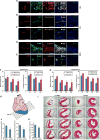Expandable Cardiovascular Progenitor Cells Reprogrammed from Fibroblasts
- PMID: 26942852
- PMCID: PMC5826660
- DOI: 10.1016/j.stem.2016.02.001
Expandable Cardiovascular Progenitor Cells Reprogrammed from Fibroblasts
Abstract
Stem cell-based approaches to cardiac regeneration are increasingly viable strategies for treating heart failure. Generating abundant and functional autologous cells for transplantation in such a setting, however, remains a significant challenge. Here, we isolated a cell population with extensive proliferation capacity and restricted cardiovascular differentiation potentials during cardiac transdifferentiation of mouse fibroblasts. These induced expandable cardiovascular progenitor cells (ieCPCs) proliferated extensively for more than 18 passages in chemically defined conditions, with 10(5) starting fibroblasts robustly producing 10(16) ieCPCs. ieCPCs expressed cardiac signature genes and readily differentiated into functional cardiomyocytes (CMs), endothelial cells (ECs), and smooth muscle cells (SMCs) in vitro, even after long-term expansion. When transplanted into mouse hearts following myocardial infarction, ieCPCs spontaneously differentiated into CMs, ECs, and SMCs and improved cardiac function for up to 12 weeks after transplantation. Thus, ieCPCs are a powerful system to study cardiovascular specification and provide strategies for regenerative medicine in the heart.
Copyright © 2016 Elsevier Inc. All rights reserved.
Figures







Comment in
-
Expansion of cardiac progenitors from reprogrammed fibroblasts as potential novel cardiovascular therapy.Stem Cell Investig. 2016 Aug 5;3:34. doi: 10.21037/sci.2016.07.06. eCollection 2016. Stem Cell Investig. 2016. PMID: 27580668 Free PMC article. No abstract available.
-
Comment on: Expandable cardiovascular progenitor cells reprogrammed from fibroblasts.Stem Cell Investig. 2016 Dec 9;3:89. doi: 10.21037/sci.2016.11.07. eCollection 2016. Stem Cell Investig. 2016. PMID: 28078269 Free PMC article. No abstract available.
References
-
- Birket MJ, Ribeiro MC, Verkerk AO, Ward D, Leitoguinho AR, den Hartogh SC, Orlova VV, Devalla HD, Schwach V, Bellin M, et al. Expansion and patterning of cardiovascular progenitors derived from human pluripotent stem cells. Nat Biotechnol. 2015;33:970–979. - PubMed
-
- Blin G, Nury D, Stefanovic S, Neri T, Guillevic O, Brinon B, Bellamy V, Rücker-Martin C, Barbry P, Bel A, et al. A purified population of multipotent cardiovascular progenitors derived from primate pluripotent stem cells engrafts in postmyocardial infarcted nonhuman primates. J Clin Invest. 2010;120:1125–1139. - PMC - PubMed
Publication types
MeSH terms
Grants and funding
LinkOut - more resources
Full Text Sources
Other Literature Sources
Medical
Molecular Biology Databases

